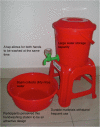Designing a handwashing station for infrastructure-restricted communities in Bangladesh using the integrated behavioural model for water, sanitation and hygiene interventions (IBM-WASH)
- PMID: 24060247
- PMCID: PMC3852554
- DOI: 10.1186/1471-2458-13-877
Designing a handwashing station for infrastructure-restricted communities in Bangladesh using the integrated behavioural model for water, sanitation and hygiene interventions (IBM-WASH)
Abstract
Background: In Bangladesh diarrhoeal disease and respiratory infections contribute significantly to morbidity and mortality. Handwashing with soap reduces the risk of infection; however, handwashing rates in infrastructure-restricted settings remain low. Handwashing stations--a dedicated, convenient location where both soap and water are available for handwashing--are associated with improved handwashing practices. Our aim was to identify a locally feasible and acceptable handwashing station that enabled frequent handwashing for two subsequent randomized trials testing the health effects of this behaviour.
Methods: We conducted formative research in the form of household trials of improved practices in urban and rural Bangladesh. Seven candidate handwashing technologies were tested by nine to ten households each during two iterative phases. We conducted interviews with participants during an introductory visit and two to five follow up visits over two to six weeks, depending on the phase. We used the Integrated Behavioural Model for Water, Sanitation and Hygiene (IBM-WASH) to guide selection of candidate handwashing stations and data analysis. Factors presented in the IBM-WASH informed thematic coding of interview transcripts and contextualized feasibility and acceptability of specific handwashing station designs.
Results: Factors that influenced selection of candidate designs were market availability of low cost, durable materials that were easy to replace or replenish in an infrastructure-restricted and shared environment. Water storage capacity, ease of use and maintenance, and quality of materials determined the acceptability and feasibility of specific handwashing station designs. After examining technology, psychosocial and contextual factors, we selected a handwashing system with two different water storage capacities, each with a tap, stand, basin, soapy water bottle and detergent powder for pilot testing in preparation for the subsequent randomized trials.
Conclusions: A number of contextual, psychosocial and technological factors influence use of handwashing stations at five aggregate levels, from habitual to societal. In interventions that require a handwashing station to facilitate frequent handwashing with soap, elements of the technology, such as capacity, durability and location(s) within the household are key to high feasibility and acceptability. More than one handwashing station per household may be required. IBM-WASH helped guide the research and research in-turn helped validate the framework.
Figures



References
Publication types
MeSH terms
Substances
LinkOut - more resources
Full Text Sources
Other Literature Sources
Medical
Miscellaneous

